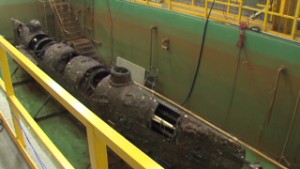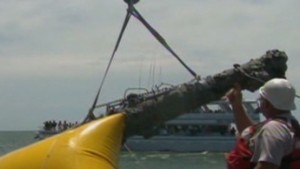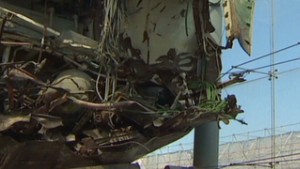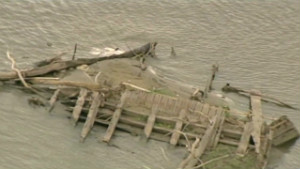African-American Savannah woman takes her place among United Daughters of the Confederacy
Posted: February 22, 2014
A Savannah native, Georgia Benton grew up hearing about the Civil War service of her great-grandfather, a slave from Sumter, S.C., who followed his master to the battles of Sharpsburg, Gettysburg and Petersburg, and then brought his body home for burial when he was struck down by artillery fire and slain during the conflict’s final days.
“He was fighting for his land and his people,” Benton said of George W. Washington, who was 16 when he entered Confederate service in 1862 as the body servant of Lt. William Alexander McQueen, who was 22.
To honor Washington and his three years of wartime service, Benton took an audacious step: She decided to join the United Daughters of the Confederacy.
“I have every right to membership in the UDC, which along with the Sons of Confederate Veterans, remembers and recognizes the men who fought for and rendered service to the South during the Civil War,” said Benton.
Putting together the proof
Elizabeth Piechocinski is the president of Savannah Chapter No. 2 of the UDC. She’s also a member of the Daughters of the Revolution, and she said that venerable organization poses fewer hurdles to prospective members than does the UDC.
“It’s a very involved process,” said Piechocinski. “You have to prove that you are a linear descendant of a Confederate, either a soldier, or someone who served in another capacity, such as a cook, laborer or musician.”
Many Confederate officers were accompanied by body servants, added Piechocinski.
The servants performed a variety of chores, and even picked up a weapon when the situation demanded it.
The story of Washington and McQueen, two young men of two different races who served under one flag, was compelling, but would not determine the final decision on Benton’s application.
“The story is nice,” said Piechocinski, “but you still have to prove it.”
A monument in Sumter
It wasn’t easy. It involved the family Bible, birth records, death records, marriage records and census records, both pre- and post-Civil War.
“Very few African-Americans” can produce that amount of documentation, said Benton.
It also took in a unique tribute to George W. Washington, a 4-foot-high obelisk at his grave in Walker Cemetery in Sumter. (A monument to McQueen, who was killed in a South Carolina battle on April 9, 1865, the same day as Gen. Robert E. Lee’s surrender, is located nearby in Sumter Cemetery.)
Washington died in 1911, and the obelisk was put up by the A.A. Solomons family of Sumter. Washington worked for the Solomons as a butler and valet for almost 40 years, said Benton, who remembers often visiting her great-grandfather’s gravesite when she was a child.
One side of the monument commemorates Washington’s Civil War service and, when the obelisk needed repairs in 2005, they were paid for by the General P.G.T. Beauregard Camp No. 1458 of the SCV in Sumter.
With the monument inscription and the other documentation, Benton’s application was approved by the national UDC in October. She thus became the first African-American member of the Savannah chapter and the only African-American member in the Georgia division of the UDC.
To honor their ancestors
A retired mathematics teacher in the Chatham County school system who now runs a tax and accounting service, Benton is going into the UDC with her head up and her eyes open.
These are “gracious women” who want to honor their ancestors, “the same as I do,” said Benton.
Benton said that she’s heard mostly positive feedback so far. As for those who have criticized her decision, “I chalk that up to ignorance,” she said.
From the UDC’s perspective, said Piechocinski, race did not enter into the decision. At the start of the application process, said Piechocinski, “we didn’t know she was African-American. This is not just some sort of gesture on our part.”
‘A true soldier’
Her great-grandfather’s Confederate service is part of the “untold” history of the South, said Benton. “They don’t teach that.”
There were many black Confederates, she said, including George W. Washington’s brother Jacob. “Uncle Jake” was a musician who played the French horn, said Benton.
George W. Washington could have run off in 1863 when he participated in the Gettysburg campaign, said Benton. “But he stayed faithful. He stayed loyal. He was a true soldier.”
Benton is not the only person in her family who wants to commemorate Southern service.
Her son, Leroy Benton Jr., has completed his application to join the local chapter of the Sons of Confederate Veterans.
“We all have a right to honor our heritage,” she said.
http://savannahnow.com/accent/2014-02-22/african-american-savanah-woman-takes-her-place-among-united-daughters-confederacy#.Uwo7N_ePJHg
“He was fighting for his land and his people,” Benton said of George W. Washington, who was 16 when he entered Confederate service in 1862 as the body servant of Lt. William Alexander McQueen, who was 22.
To honor Washington and his three years of wartime service, Benton took an audacious step: She decided to join the United Daughters of the Confederacy.
“I have every right to membership in the UDC, which along with the Sons of Confederate Veterans, remembers and recognizes the men who fought for and rendered service to the South during the Civil War,” said Benton.
Putting together the proof
Elizabeth Piechocinski is the president of Savannah Chapter No. 2 of the UDC. She’s also a member of the Daughters of the Revolution, and she said that venerable organization poses fewer hurdles to prospective members than does the UDC.
“It’s a very involved process,” said Piechocinski. “You have to prove that you are a linear descendant of a Confederate, either a soldier, or someone who served in another capacity, such as a cook, laborer or musician.”
Many Confederate officers were accompanied by body servants, added Piechocinski.
The servants performed a variety of chores, and even picked up a weapon when the situation demanded it.
The story of Washington and McQueen, two young men of two different races who served under one flag, was compelling, but would not determine the final decision on Benton’s application.
“The story is nice,” said Piechocinski, “but you still have to prove it.”
A monument in Sumter
It wasn’t easy. It involved the family Bible, birth records, death records, marriage records and census records, both pre- and post-Civil War.
“Very few African-Americans” can produce that amount of documentation, said Benton.
It also took in a unique tribute to George W. Washington, a 4-foot-high obelisk at his grave in Walker Cemetery in Sumter. (A monument to McQueen, who was killed in a South Carolina battle on April 9, 1865, the same day as Gen. Robert E. Lee’s surrender, is located nearby in Sumter Cemetery.)
Washington died in 1911, and the obelisk was put up by the A.A. Solomons family of Sumter. Washington worked for the Solomons as a butler and valet for almost 40 years, said Benton, who remembers often visiting her great-grandfather’s gravesite when she was a child.
One side of the monument commemorates Washington’s Civil War service and, when the obelisk needed repairs in 2005, they were paid for by the General P.G.T. Beauregard Camp No. 1458 of the SCV in Sumter.
With the monument inscription and the other documentation, Benton’s application was approved by the national UDC in October. She thus became the first African-American member of the Savannah chapter and the only African-American member in the Georgia division of the UDC.
To honor their ancestors
A retired mathematics teacher in the Chatham County school system who now runs a tax and accounting service, Benton is going into the UDC with her head up and her eyes open.
These are “gracious women” who want to honor their ancestors, “the same as I do,” said Benton.
Benton said that she’s heard mostly positive feedback so far. As for those who have criticized her decision, “I chalk that up to ignorance,” she said.
From the UDC’s perspective, said Piechocinski, race did not enter into the decision. At the start of the application process, said Piechocinski, “we didn’t know she was African-American. This is not just some sort of gesture on our part.”
‘A true soldier’
Her great-grandfather’s Confederate service is part of the “untold” history of the South, said Benton. “They don’t teach that.”
There were many black Confederates, she said, including George W. Washington’s brother Jacob. “Uncle Jake” was a musician who played the French horn, said Benton.
George W. Washington could have run off in 1863 when he participated in the Gettysburg campaign, said Benton. “But he stayed faithful. He stayed loyal. He was a true soldier.”
Benton is not the only person in her family who wants to commemorate Southern service.
Her son, Leroy Benton Jr., has completed his application to join the local chapter of the Sons of Confederate Veterans.
“We all have a right to honor our heritage,” she said.
http://savannahnow.com/accent/2014-02-22/african-american-savanah-woman-takes-her-place-among-united-daughters-confederacy#.Uwo7N_ePJHg



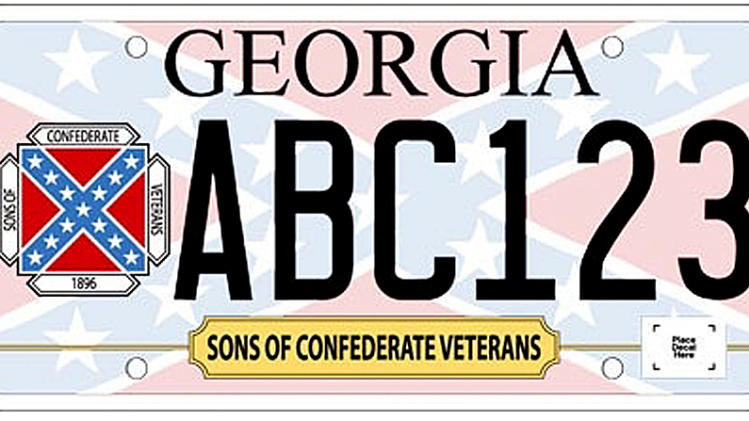
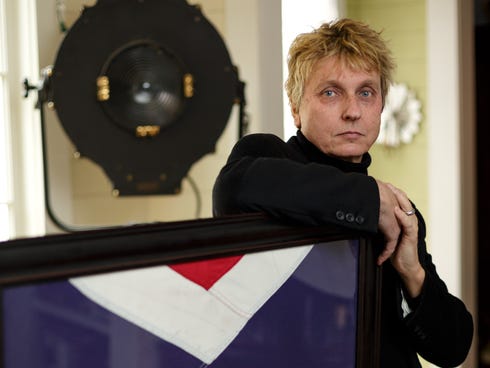
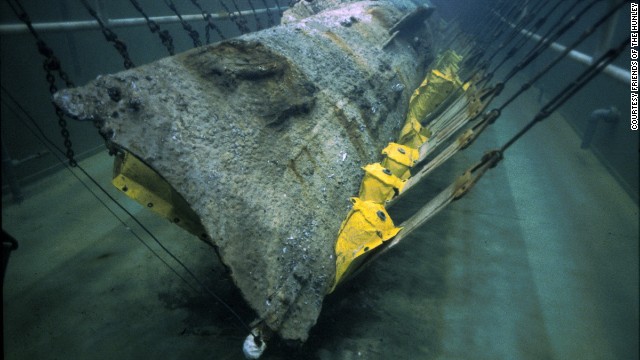 For nearly 14 years, scientists, historians and a genealogist have studied the first submarine to sink an enemy vessel. The H.L. Hunley did just that 150 years ago, February 17, 1864, during the American Civil War.
For nearly 14 years, scientists, historians and a genealogist have studied the first submarine to sink an enemy vessel. The H.L. Hunley did just that 150 years ago, February 17, 1864, during the American Civil War.
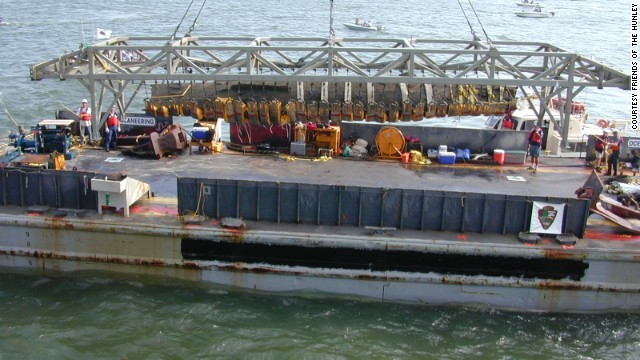 The 40-foot submarine was brought up amid much fanfare off Charleston, South Carolina, in August 2000. Author Clive Cussler and a team discovered the Hunley five years earlier, buried in the sand more than 100 yards beyond its target, the USS Housatonic.
The 40-foot submarine was brought up amid much fanfare off Charleston, South Carolina, in August 2000. Author Clive Cussler and a team discovered the Hunley five years earlier, buried in the sand more than 100 yards beyond its target, the USS Housatonic.
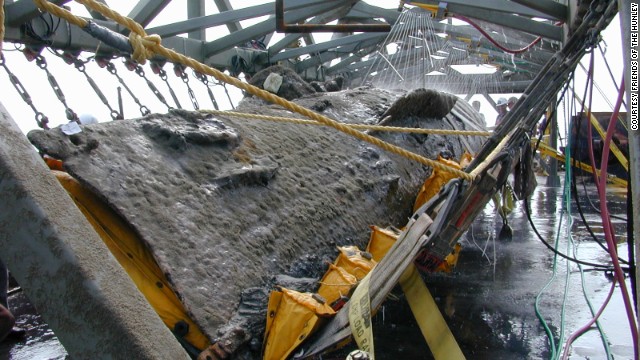 Conservators later this year will begin a new process -- filling the tank that holds the Hunley with chemicals that will strip away what is called "concretion": organic material that has coated the hull and interior.
Conservators later this year will begin a new process -- filling the tank that holds the Hunley with chemicals that will strip away what is called "concretion": organic material that has coated the hull and interior.
 Visitors to a laboratory and exhibit hall in North Charleston, South Carolina, can gaze down on the Hunley on weekends. The large tank is empty when scientists in the Hunley Project are at work.
Visitors to a laboratory and exhibit hall in North Charleston, South Carolina, can gaze down on the Hunley on weekends. The large tank is empty when scientists in the Hunley Project are at work.
 The hull is in pretty good shape, despite exposure to sea currents and elements for decades. The eight-member Confederate crew, sitting on the port side, turned a propeller by hand.
The hull is in pretty good shape, despite exposure to sea currents and elements for decades. The eight-member Confederate crew, sitting on the port side, turned a propeller by hand.
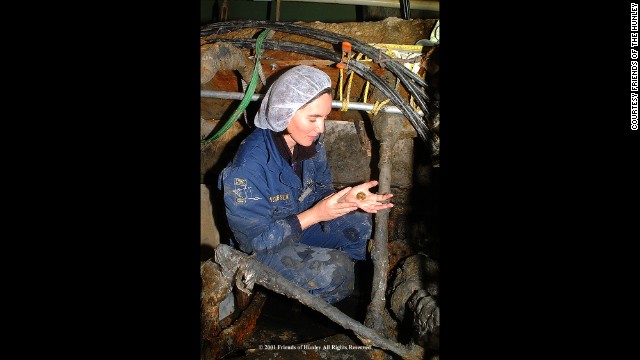 Several years ago, then-senior archaeologist Maria Jacobsen found a gold coin that belonged to submarine commander Lt. George Dixon.
Several years ago, then-senior archaeologist Maria Jacobsen found a gold coin that belonged to submarine commander Lt. George Dixon.
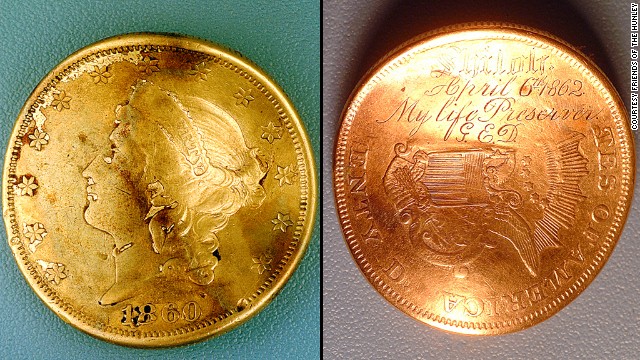 Lt. George Dixon, according to legend, received this coin as a good-luck charm from his beloved, said to be from Mobile, Alabama. It was bent by a bullet when he was wounded at the Battle of Shiloh, two years before the Hunley made history. He had it engraved and carried it the rest of his life. It was found with his remains by Hunley Project scientists.
Lt. George Dixon, according to legend, received this coin as a good-luck charm from his beloved, said to be from Mobile, Alabama. It was bent by a bullet when he was wounded at the Battle of Shiloh, two years before the Hunley made history. He had it engraved and carried it the rest of his life. It was found with his remains by Hunley Project scientists.
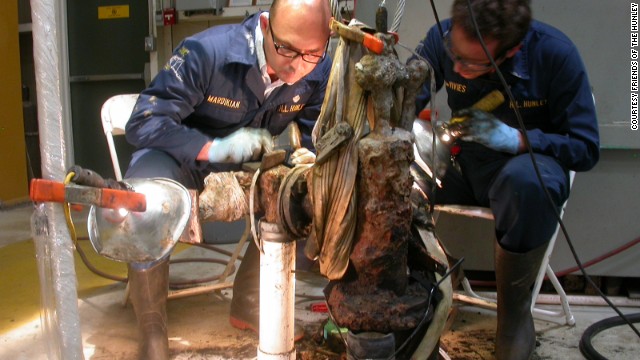 Paul Mardikian, left, senior conservator, and Philippe de Vivies remove material from a piece of the submarine.
Paul Mardikian, left, senior conservator, and Philippe de Vivies remove material from a piece of the submarine.
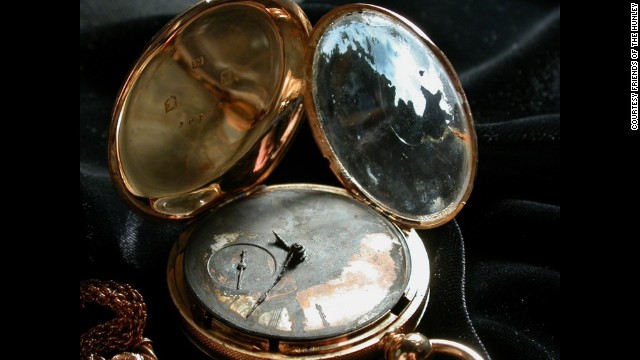 One of the personal belongings found inside the Hunley, a watch belonging to Lt. George Dixon.
One of the personal belongings found inside the Hunley, a watch belonging to Lt. George Dixon.
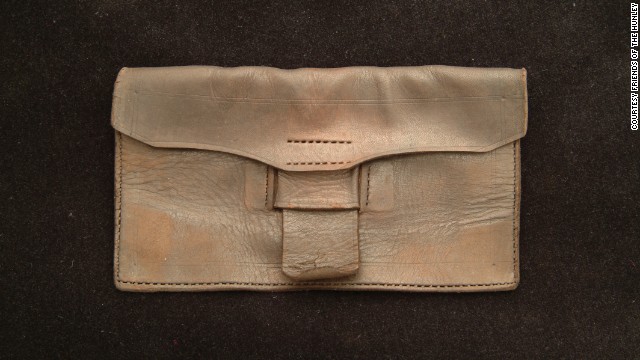 A wallet found in the shipwreck helps tells the story of ordinary life onshore.
A wallet found in the shipwreck helps tells the story of ordinary life onshore.
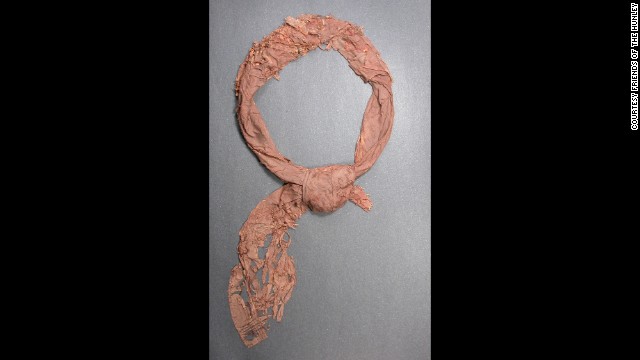 Crew member James Wicks' bandana after conservation.
Crew member James Wicks' bandana after conservation.
 This burnt matchstick was found buried in the sediment-filled interior of the H.L. Hunley.
This burnt matchstick was found buried in the sediment-filled interior of the H.L. Hunley.
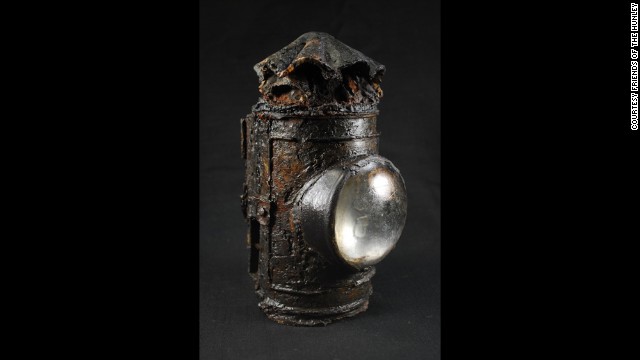 Experts believe this lantern was used as a flashlight by the submarine's commander.
Experts believe this lantern was used as a flashlight by the submarine's commander.
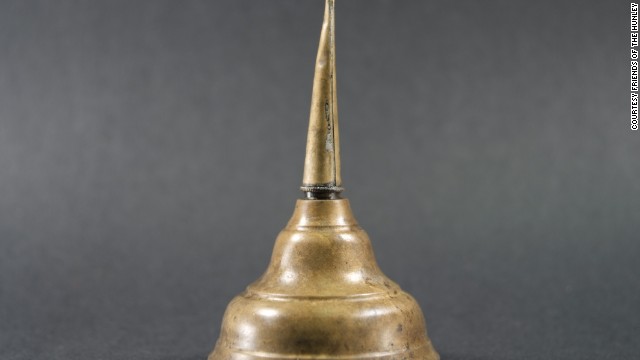 This conserved oil can almost looks good as new.
This conserved oil can almost looks good as new.
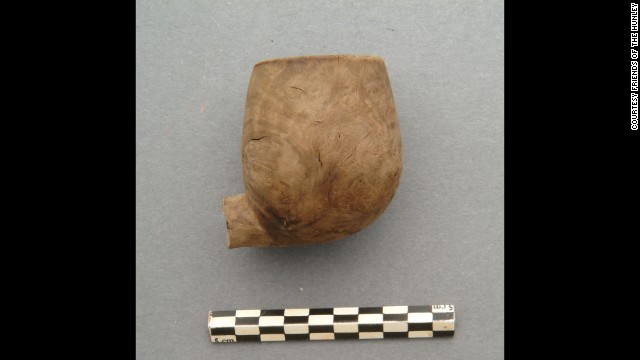 The bowl of a pipe belonging to Confederate sailor Joseph Ridgaway, the only crew member positively identified through DNA.
The bowl of a pipe belonging to Confederate sailor Joseph Ridgaway, the only crew member positively identified through DNA.
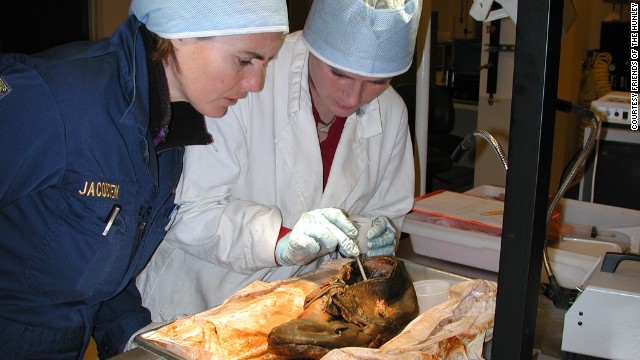 Experts examine a shoe found on the H.L. Hunley.
Experts examine a shoe found on the H.L. Hunley.

